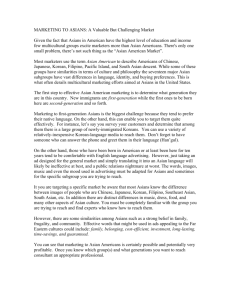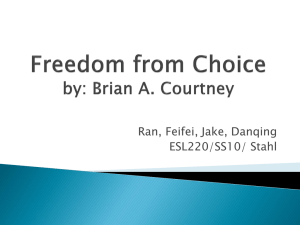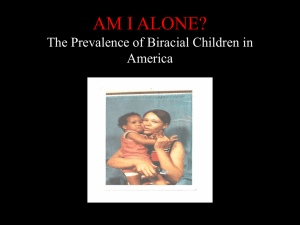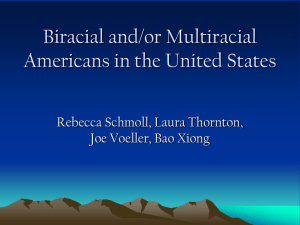Viana_DocTopicReview
advertisement
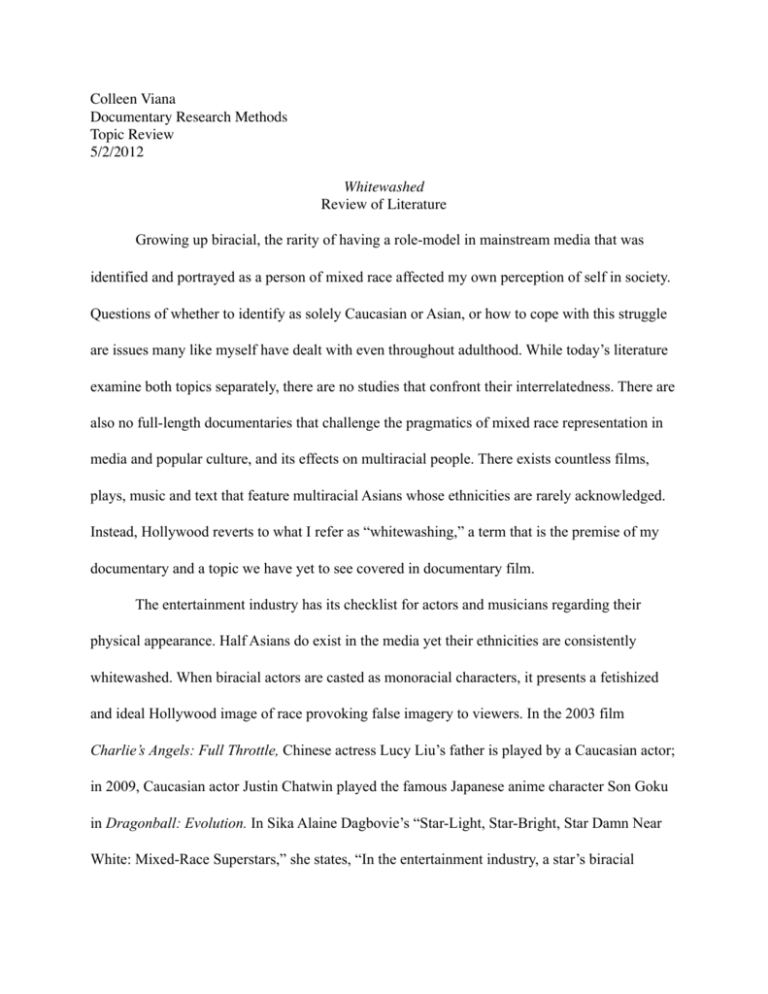
Colleen Viana Documentary Research Methods Topic Review 5/2/2012 Whitewashed Review of Literature ! Growing up biracial, the rarity of having a role-model in mainstream media that was identified and portrayed as a person of mixed race affected my own perception of self in society. Questions of whether to identify as solely Caucasian or Asian, or how to cope with this struggle are issues many like myself have dealt with even throughout adulthood. While today’s literature examine both topics separately, there are no studies that confront their interrelatedness. There are also no full-length documentaries that challenge the pragmatics of mixed race representation in media and popular culture, and its effects on multiracial people. There exists countless films, plays, music and text that feature multiracial Asians whose ethnicities are rarely acknowledged. Instead, Hollywood reverts to what I refer as “whitewashing,” a term that is the premise of my documentary and a topic we have yet to see covered in documentary film. The entertainment industry has its checklist for actors and musicians regarding their physical appearance. Half Asians do exist in the media yet their ethnicities are consistently whitewashed. When biracial actors are casted as monoracial characters, it presents a fetishized and ideal Hollywood image of race provoking false imagery to viewers. In the 2003 film Charlie’s Angels: Full Throttle, Chinese actress Lucy Liu’s father is played by a Caucasian actor; in 2009, Caucasian actor Justin Chatwin played the famous Japanese anime character Son Goku in Dragonball: Evolution. In Sika Alaine Dagbovie’s “Star-Light, Star-Bright, Star Damn Near White: Mixed-Race Superstars,” she states, “In the entertainment industry, a star’s biracial identity may fade, be tucked away or even disappear according to audience perceptions and star construction” (2007, 219). Though the author primarily focuses on African American celebrities, she makes a clear point that these biracial stars’ roles can easily be reduced to either “tragic or exotic” (Dagbovie 2007, 221). Actor Dean Cain, who is half Japanese, is known for his role as Clark Kent/Superman in the television series Lois & Clark: The New Adventures of Superman. While Cain does not play an Asian character, there is an underlying tragedy in the role of Clark having to be two separate people, which is essentially what biracial actors must struggle with. Exoticism is portrayed in the recent series Nikita where lead actress Maggie Q, half Vietnamese, is the typical dominatrix, yet her ethnicity is never acknowledged. These are two prime examples of whitewashing and they have yet to be exposed in documentary cinema. In “The Souls of Mixed Folk: Race, Politics, and Aesthetics in the New Millennium,” Michele Elam briefly addresses that an arbitrary power exists in the entertainment business in “settling who’s who racially” (2011, 162). Referred to as “deciders,” these media officials “often have their own reputations to uphold and so are less than disinterested in certain racial outcomes, their assessments motivated by a plethora of personal and institutional concerns” (Elam 2011, 162). Between the years 2000 and 2009, a systematic typecast of Asian characters on film were analyzed by Liu Xing in “Asians in Top 10 Box Office Films.” Of the thirty films studied, Asian actors were often reduced to fit these types of roles: the “pollutant” (unacculturated and unfriendly individual), the “coolie” (sweat laborer), the cartoon character, “yellow peril” (villain), “model minority” (successful and smart), or the “gook” (enemy soldier) (Xing 2010, 40-43). What is more disturbing than this is the fact that those Asians who ultimately play these minor roles are always monoracial. The films analyzed by Xing, like Harry Potter and the Order of the Phoenix, Twilight: New Moon, and The Last Samurai, that feature Asians with minor roles are never played by biracial actors. Does Hollywood purposefully set aside these roles for monoracial Asians, while casting the part Asian stars as the romanticized Caucasian character? No literature or media can answer this question I want to answer using these authors’ theories. Perhaps the subject of physical appearance and attraction can explain this issue in typecasting monoracial and biracial individuals in film and television. In 2010, Dr. Michael Lewis of Cardiff University, School of Psychology, concurred in his study that a “small but highly significant effect, with mixed-race faces, on average, [are] perceived as more attractive.” An idea first conceived by Darwin in 1876, “heterosis (a universal biological effect)...predicts that cross-breeding leads to offspring that are genetically fitter than their parents” which can explain Lewis’ findings of those with diverse backgrounds are “more attractive” (Lewis 2010). In support of this, Gillian Rhodes says in “The Evolutionary Psychology of Facial Beauty” that a preference for mixed race faces does exist, even stating that they “look healthier than single-race faces” (2006, 216). These two studies about facial beauty lead me to investigating another component of whitewashing that happens under the knife. In some Asian cultures, facial features of Caucasians are said to be “prized,” according to Anupreeta Das. In “The Search for Beautiful,” Das says the eyelid surgery, which creates the eye to appear bigger and wider by constructing an eyelid fold, is popular amongst Asians. Of course, this concept of “the double eyelid as beautiful comes from the West,” she says. There are Asians who strive for these cosmetic surgical procedures that are “Caucasian-inspired,” notes Das, “the big-eyed, narrow-nosed, pillow-lipped, large-breasted, boyishly thin apparition.” A CNN report from May 23, 2011 highlights a South Korean 12 yearold ballerina who is in the process of undergoing upper eyelid surgery. With the permission of her mother, the adolescent yearns for more Westernized eyes in which her mother said, "I'm having her do it because I think it'll help her. This is a society where you have to be pretty to get ahead.” In Seoul, CNN interviewed Dr. Kim Byung-gun who is the head of South Korea’s largest plastic surgery clinic which perform 100 surgeries a day. “The Chinese and Korean patients tell me that they want to have faces like Americans,” Dr. Kim said, to which many Asian activists see as a form of “cultural imperialism.” Korea is said to have the second most number of plastic surgery operations, with Hungary coming in first, according to a Toronto Sun report from February 17, 2012. One of the country’s most popular websites is called Yeowooya, boasting 550,000 followers, which features a plethora of before and after shots of Korean cosmetic surgeries. Journalist Eun Jee Park interviewed the website’s unnamed “Plastic Surgery Queen of the Week” who said, “I am now able to attract a boyfriend after undergoing a facial liposuction surgery.” A South Korean filmmaker Kim Ki-duk premiered Time (2006), a romance that involves a young Korean woman who is influenced by her love interest to “undergo facial cosmetic surgery in a bid for rejuvenation.” The recurring theme of wanting to look more attractive for someone else, whether a partner or movie director, has a dismal effect on non-Western cultures. There are two documentaries on cosmetic surgery undergone by Asians and other minorities which I find valuable to my understanding of the topic. The first is by Ann Shin, called Western Eyes (2000), and it follows two women who contemplate eyelid surgery and rhinoplasty due to their uncomfortableness with Asian features. “The closer you resemble Europeans, the better and more beautiful you are,” Maria, a Filipino woman said. In the film, Maria admitted that if she could get the surgery, it would “free me from my cocoon,” and she would have the face she feels she belongs in. British filmmaker Krishnendu Majumbar addresses these surgical issues as “de-racialization” in his documentary Bleach, Nip. Tuck: The White Beauty Myth. This theory on plastic surgery proves accurate as he interviews a wide spectrum of ethnic minorities, from Malaysian to Caribbean and Indian, that want to look whiter and more European. An African American girl goes so far as to compare her features to that of a Barbie doll which she describes as “perfect.” Though the film has a UK perspective, embedded with many notions of colonialism in East Asian culture (an effect on many surgeries), the film poses ideas that are invaluable to my documentary; questioning if whites are “superior?” and is this an effect of Western or Americanized globalization? I want to answer these questions by looking at Asian film and pop stars that have undergone cosmetic surgery in order to appeal to an audience that values westernized features over their own. This topic has yet to be addressed in documentary. In accordance to cultural studies is Roland Barthes’ theory on semiotics, defined as “the discipline studying everything which can be used in order to lie” (Griffin, 358). The logic to this is that if something cannot be used to tell a lie, then it cannot be used to tell the truth; therefore, it cannot be used to tell at all. Signs always have a purpose, and Barthes was particularly interested in the way signs can subtly communicate ideologies that perpetuate dominant social values. Using these methodologies, it is evident that some force within our western society is dominating ideals on beauty and image, so much for millions of people to undergo plastic surgery. Scholars have linked the study of superstructural ideologies within the media to a capitalist agenda in Asia, for example (Fung, 162). Conversely, M. Bjørn von Rimscha and Gabriele Siegert’s study supports that the two objectives entertainment producers have is “to entertain and to maximize profit” (1010). Rather than suggesting that the presence of race in film and television is correlated to capitalism, it is difficult to ignore that is represents a signifier of a greater social agenda, signified by the way racial cultures are portrayed in such media texts (Fung, 155; von Rimscha & Siegert, 1010-1011). While racial ambiguity in film and other media tread toward racial identity for multiracial public figures have been largely depoliticized by mainstream media. Because entertainment has an impact on “the public sphere, on cultural citizenship, and on (political) norms and values,” according to von Rimscha and Siegert (1010), the power held by media officials affect the scope of popular culture and its consumers. For example, actress Jessica Alba, who is part Mexican and Danish, has purposefully turned down Latina roles because she cannot relate to the race or promote Latina stereotypes, she said in an interview (MeditaTakeOut.com 2007). Keanu Reeves, half-Chinese, and Cameron Diaz, half-Cuban, also make up the long list of actors that are viewed primarily as Caucasian and monoracial in the media. Being casted as protagonists and drawing people to the box office comes at a cost must when these biracial actors negate their cultural and ethnic identity. There is no relevant literature that addresses the important role multiracial celebrities play in the racial identification of their fan and the general public. I plan to examine their silences voices and ambiguity in entertainment as a way of understanding how the multiracial celebrity copes with identity. Often, multiracial individuals are asked the painstaking question, “what are you?,” referring to his/her racial background. Documentary filmmakers like Jeff Chiba Stearns (One Big Hapa Family), Kip Fulbeck (Banana Split), and Anne Marie Nakagawa (Between: Living in the Hyphen) have addressed this issue of society’s biracial curiosity. Because mixed race people in the media are portrayed so ambiguously, growing up as half Caucasian and half Filipino like me, for example, I had no one in entertainment and the public eye to look up or relate to. In Kip Fulbeck’s (who is half Chinese and Caucasian) nine minute video, Lilo and Me, he comically juxtaposes his uncanny resemblance to Disney cartoon characters like Aladdin and Lilo & Stitch to the few images of Asian actors that fit specific roles in cinema, primarily kung-fu. Contrastingly, a study by Liu Xing statistically shows that between the years 2000 and 2009, only one out of 121 Asian actors had a leading role in film (2010, 38). Xing states, “Asians’ insignificant places in the films, their no-name status and the interchangeable portrayal of Asian characters also imply symbolic annihilation” (2010, 39). By typecasting minorities in the media to the point of it being racial profiling, both biracial and non-Caucasian monoracial individuals are left in the dust. Ontology allow us to determine our nature of being, our existence and the way we see things, resulting in the construction of what we know and/or believe. Our social, cultural, and educational experiences provide the basis to how we act, talk, and perceive the world and ourselves. In his Booker Prize-winning essay on art criticism, Ways of Seeing, John Berger claims, “We never look at just one thing; we are always looking at the relation between things and ourselves” (Elam 2011, 160). Both negative and positive portrayal of race in media, therefore prompt us to consider that such images can never be perceived as just “one thing” or belonging to just one person. Instead, being mixed race is relational among things and people. This is a large factor that affects those minority individuals that strive to look more white, or multiracials that are sometimes reduced to having just one race, notably in the public eye. When Stuart Hall mediated cultural studies in the 1970s, he sought to “articulate the perception of the cultural struggle between the haves and the have-nots,” in which the media is providing the platform where meaning is shaped (Griffin 2006, 371). Hall states, “reality is never experienced directly but always through the cultural categories made available by society” (Osei-Kofi, 213). Today, the promotion of multiculturalism and racial diversity can help synthesize positive portrayals of the minority in film and television that multiracial individuals can finally look up to (Beltran, 49, 63 & Osei-Kofi, 220). There is no better time than now to produce a documentary where these issues are raised. Though it is already 2012, there is still racial discrimination in the entertainment industry, and false ideals of perfection that drive many women and men to no limits to try and achieve it. With a growing number of multiracial individuals in the world, images of what society tries to portray of black, white, and all sides of race, are becoming less accurate (if they ever were). I would like to see funding from the Asian Cinema Fund, which supports projects worldwide. My target audience is not limited to only Asians, however, since I am also concentrating on the topic of mixed race. This provides a wider market, and will feature not only subjects from the U.S. in terms of celebrity, but in Asia where the problem of “de-racialization” exists due to whitewashing. I see this as an important film not only for us locally, but for the global community that is affected by this daunting term: whitewash. bibliography Beltran, M. (2005). The new Hollywood racelessness: Only the fast, furious, (and multiracial) will survive. Cinema Journal, 44((2), 50-67. Cardiff University News Centre. (2010 April 14). Mixed-race people perceived as ‘more attractive.’ Retrieved via http://www.cardiff.ac.uk/news/articles/mixed-race-people-perceived-as-moreattractive-4286.html CNN. Lah, K. (2011 May 23). Plastic surgery boom as Asians seek ‘western’ look. Retrieved via http://www.cnn.com/2011/WORLD/asiapcf/05/19/korea.beauty/index.html Dagbovie, S.A. (2007). Star-light, star-bright, star damn near white: Mixed-race superstars. The Journal of Popular Culture, 40(2), 217-237. Das, A. (2007 Jan 21). The search for beautiful. Boston Globe, 22. Retrieved via ProQuest, http://search.proquest.com.libproxy.newschool.edu/docview/405046323? accountid=12261 Elam, M. (2011). “Performing mixed race in Dave Chappelle’s ‘The racial draft’ and Carl Hancock Rux’s ‘Talk’ in The souls of mixed folk: Race, politics, and aesthetics in the new millennium, (160-204). Stanford University Press. Fulbeck, K. (2003). Lilo & me. Retrieved via http://www.vdb.org/titles/lilo-me Fung, A. (2000). Feminist philosophy and cultural representation in the Asian context. International Communication Gazette, 62(2), 153-165. Griffin, E. (2006). Cultural studies in A first look at communication theory, (370-384). McGraw Hill. Majumbar, K. Bleach, nip, tuck: The white beauty myth. Retrieved via http://www.worldstarhiphop.com/videos/video.php?v=wshhbwgeAR5mddmM0c3m MediaTakeOut.com. (2007 June 17). Jessica Alba: Don’t call me a Latina! Retrieved via http://www.mediatakeout.com/7187/jessica_alba_dont_call_me_a_latina.html Osei-Kofi, N. Multiracialization, “mixing,” and media pedagogy in Bi- and multiracial millenials in college, 213-226. Rhodes, G. (2006). The evolutionary psychology of facial beauty. Annual Review of Psychology, 57, 199-226. Shin, A. (2000). Western eyes. Retrieved via http://www.nfb.ca/film/western-eyes Toronto Sun. Park, E.J. (2012 Feb 17). Korea’s plastic surgery obsession sparks concern. Retrieved via http://www.torontosun.com/2012/02/17/koreas-plastic-surgery-obsession-sparks-concern von Rimscha, M.B. & Siegert, G. (2011). Orientations of entertainment media workers: Entertainment media workers – disrespect and neglect. Media Culture Society, 33(7), 1009-1026. Xing, L. (2010). Asians in top 10 box office films (2000-2009). University of Kansas, 3-73.



